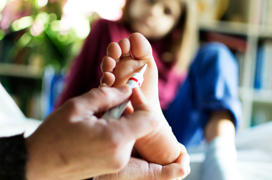Fungal Infections

Types of Fungal Infections
Fungal infections may occur anywhere on or within the body. The most common types are the following:
- Athlete's foot, fungal infection of the feet and toes
- Jock itch, a fungal infection of the groin and armpit area
- Yeast infection, also known as candidiasis
- Ringworm, a fungal infection of the skin and scalp
- Onychomycosis, or infection of the nail and nail bed
- Sinus infections
Most fungal infections are highly contagious and can be spread from human-to-human, animal-to-human or object-to-human. While many parts of the human body have immune mechanisms which fight off fungal infections, they may be spread if the immune system is compromised. Additionally, prolonged use of antibiotics or hormone changes, such as menopause in women, will also make the body more vulnerable to fungal infections.
Symptoms of Fungal Infections
Each type of fungal infection appears with its own set of symptoms. Fungal infections of the skin tend to present themselves with redness or visible spots, as well as itchiness and scaling and cracking of the skin. Nail infection symptoms may include white or yellow streaks, nail buildup, and brittle damage or thickness. Yeast infection symptoms may include genital itching, burning, and a white discharge. Sinus fungal infections may include fever, headache and sinus pain or blockage. These symptoms may differ based upon the specific type of fungus.
Treatment of Fungal Infections
Fungal infections can usually be successfully treated with over-the-counter antifungal oral or topical medications. They are not usually serious, but may be contagious, so treatment is important. Fungi can be difficult to kill. For skin and nail infections, antifungal medications can be applied directly to the infected area. Oral antifungal medicines are also available for fungal infections in other areas of the body, and for more serious nail and skin infections.
Prevention of Fungal Infections
There are several steps which may be taken to prevent fungal infections, including:
- Avoiding prolonged use of antibiotics or steroids
- Eating a balanced diet
- Proper management of blood sugar levels in diabetics
- Keeping the body clean and dry
- Changing socks and underwear everyday
- Avoiding walking barefoot, especially in common areas
- Discarding old boots, shoes, and slippers
- Washing hands often, especially after contact with animals or other people
- Avoiding close contact to soil or dust, such as through gardening or yard work
Herpes Simplex Virus (cold sores)
Cold sores, also known as fever blisters, are among the most common oral lesions, occurring on the lips or around the mouth. These sores, which are often painful, are caused by the herpes simplex virus. There are two types of herpes simplex virus, HSV-1 and HSV-2. Cold sores are usually caused by HSV-1, while HSV-2 is usually the cause of genital herpes.
The same virus that causes cold sores may also result in other symptoms, including fever, sore throat and swollen glands. Cold sores are normally diagnosed through physical examination alone, unless the physician suspects another variety of lesion.
Cold sores are highly contagious. Usually, the herpes virus affects the body when infected fluid enters a break in the skin. This typically happens through saliva contact, either through kissing or the use of shared eating utensils. Once an individual is infected, the virus can spread to other parts of the body. It is also possible for a person to have the herpes virus without visible cold sores.
There is no cure for cold sores, but they frequently go away after a few days without treatment. If a cold sore opens, lymph, a clear fluid, may drain from it. The cold sore will then typically form a scab. The cold sore scab normally heals within a few days to 2 weeks. Once an individual has contracted the virus, however it remains in the body and may precipitate subsequent outbreaks.
Outbreaks of cold sores tend to happen when the immune system is weakened: during or after an illness, during menstruation, or when an individual is under great stress. There are several topical treatment options available over-the-counter to hasten healing and lessen pain.
Warts
Warts are a common skin condition resulting from infection by one or another strain of human papillomavirus (HPV). There are several types of warts that can affect individuals of any age, but some types are more commonly found in children and some more often found in adults. Many types of warts, especially those usually found on children, disappear on their own. When troublesome, warts can be treated with medications or otherwise removed.
Patients with weakened immune systems, such as those with HIV or other immune disorder or those who have had organ transplants, are particularly susceptible to warts. Since warts are contagious through direct skin contact, strict personal hygiene can help to prevent their spread. This includes avoidance of shared personal items, such as towels or razors.
Warts appear as small skin growths, flat or slightly raised, on the surface of the skin. They can vary in coloration. Usually warts can be diagnosed by a simple medical examination, but occasionally a biopsy may be necessary to distinguish them from particular kinds of skin cancer. Different types of warts appear on different parts of the body and vary in appearance. Some of the most common varieties of warts are:
- Common warts, which usually appear on the fingers or toes
- Flat warts, common on face, arms or legs
- Plantar warts, which grow on the soles of the feet
- Filiform warts, which grow on the face or neck
- Periungual warts, which grow around or under toenails and fingernails
While most varieties of warts are benign, they may be itchy, painful or embarrassing. Most can be treated through the application of medications like salicylic acid or cantharidin or through cryotherapy, a process of freezing with liquid nitrogen. In especially resistant instances, warts may require laser surgery or surgical excision with a scalpel. In most cases, treatment is permanent and warts do not return.




